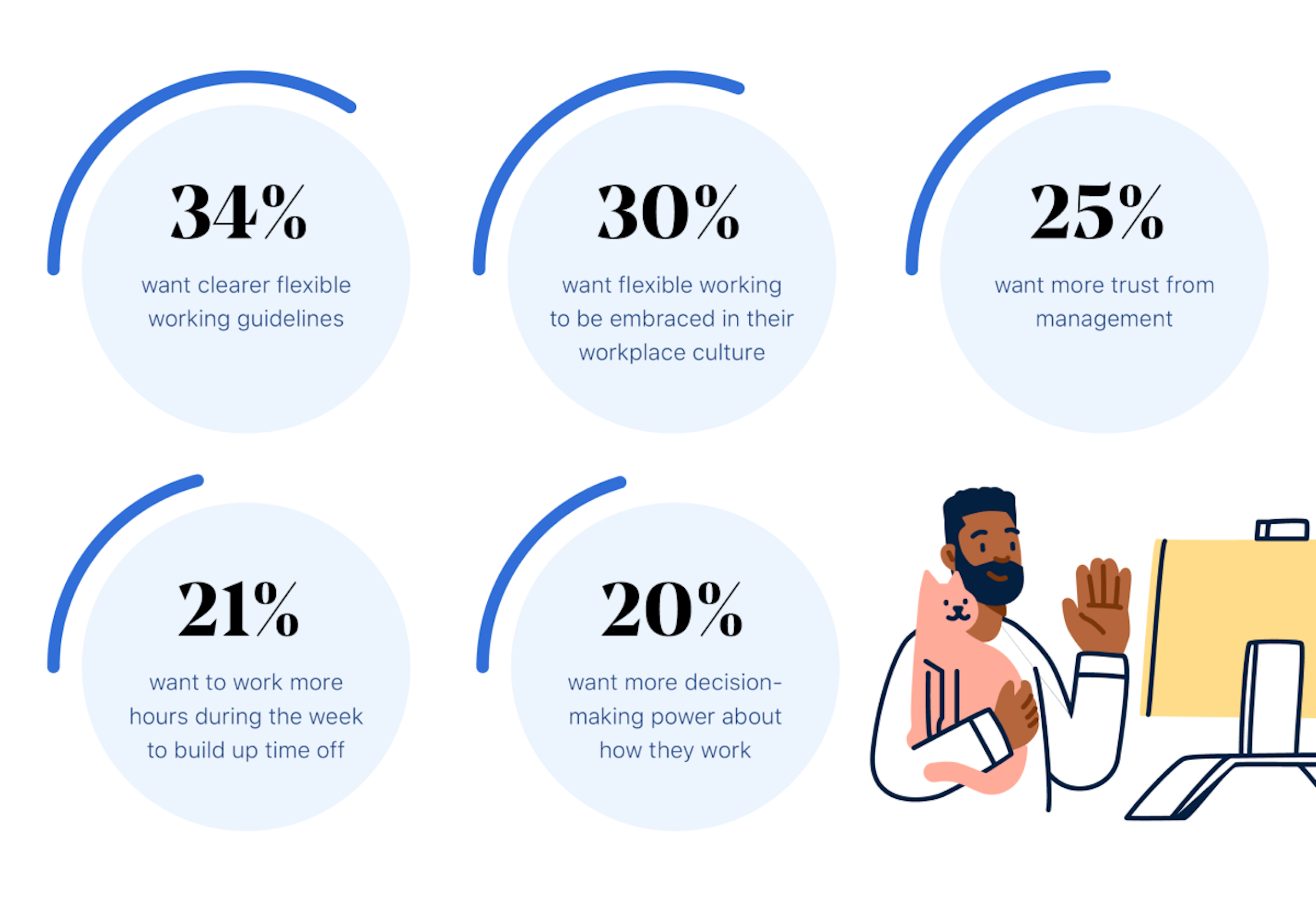How To Create Great Flexible Working Policies


If there’s one item that’s shot to the top of the UK business agenda, it's setting up a flexible working policy.
Recent changes to UK law and, of course, the impact of the COVID-19 Pandemic, have made flexibility one of the hottest workplace topics. But as COVID-19 begins to fade in our collective rearview mirrors, many companies are still finding their feet around this complex subject.
Of the 2,000 employees we recently surveyed, 83% felt their company’s current flexible working practices needed drastic improvement.
So, to help plug the flexible working policy ‘gap’, we’ve laid out a step-by-step process for drafting effective flexible workplace policies, including some of our best practices and examples for putting together a flexible working policy template that can ‘flex’ and evolve with your growing business.
But to start…
What is a flexible working policy?
You can think of this as a set of rules and guidelines that define your company’s approach to working flexibly. This might include (but is not limited to) the purpose of the policy, the flexible working arrangements your company is comfortable supporting as well as any limitations.
This set of rules could take the form of a document you share across your organisation or an e-booklet or wiki that all personnel and managers have quick access to. Every company is unique, so how your business shares and communicates these guidelines might look different from how another organisation does this.
What are the UK’s new rules for flexible working in 2024?
At a minimum, you’ll want to ensure any flexible working policy you put in place accounts for the law on flexible working recently published in the UK. Before this new legislation came into play, employees would need to wait 26 weeks before they could submit a flexible working request. Under these new rules, employees are entitled to this right from day one of their job. But as we’ll explore further, there’s a lot more that goes into crafting credible and, most importantly, clear guidelines.
What do employees need most from flexible working policies?
On this subject, our recent survey into flexible working revealed what employees want most from flexible working policies - and that’s clearer guidelines.
Over the Pandemic, businesses had to adapt swiftly. But because of this, many employees are now expressing that a lack of clarity is getting in the way of them actually taking up flexible policies.
Our survey revealed the extent of this dysfunction - 34% of employees shared they wanted clearer guidelines around what they can and cannot do when working flexibly for their organisation. 18% also expressed they didn’t feel comfortable requesting more flexible working arrangements from their manager(s) for fear of how they might be perceived.
This suggests UK leaders are finding it challenging to translate the need for more flexible working hours into clear and transparent workplace policies.

How to create a flexible working policy in the UK
With trust, transparency and clarity in mind, there are some steps you can take with your organisation to start working towards putting a flexible policy together, including:
Defining your business objectives
Understanding what your employees are entitled to
Assessing the needs of your organisation
Considering the types of flexible working arrangements you want to offer
Getting feedback from employees as to what they want
Training managers on how to implement and oversee policies
While it might be tempting to skip some of these steps and go straight to writing your policies, working through each of these steps will ensure you put together something that truly caters to the needs of your business and its staff.
Start by defining some business objectives
Before you even put pen to paper, you need to have a clear idea of what you want to achieve with your flexible workplace policy.
Is it to improve employee retention? To reduce costs, or your carbon footprint? Or is it simply because it’s what your employees want? There’s no right or wrong answer here - just the answer that makes the most sense for your business and which ties into your greater overarching strategy and culture.
Actions for HR leaders
Embed flexible working practices within company values, culture and expected behaviours so these become ‘the norm’ for employees at all levels.
Understand what employees are entitled to
As we mentioned before, employees now have the right to request a flexible working arrangement that suits their needs from day one of their employment. So, it’s important to ensure all stakeholders - including leaders and managers - have a clear understanding of the legislation so they don’t inadvertently become legal roadblocks.
At a minimum, you’ll want to include a clear explanation of this entitlement in any policy you draft.
Assess the needs of your organisation
On the other hand, it’s equally vital to understand what your organisation can or can’t do when it comes to flexibility beyond what’s legally required, of course. It’s important to stop and think about what’s realistic for your business. Health and safety issues, confidentiality, demands on team resources or a role’s specific structure can all place limitations on your policies.
Actions for HR leaders
Provide (real) childcare support by building a culture that normalises feeding, school pick-ups and fitting other childcare requirements around work.
Consider the types of arrangements you want to offer
There are many different types of flexible working arrangements. Your company might not be able (or want) to offer all of these. Still, you should list the kinds of flexible working patterns and practices you want your business to support so employees have all the options to hand.
Get feedback on what your employees want
On the subject of employees, it’s crucial to ask your staff - both managers and their direct reports - what they want from a flexible working policy.
The key here is to really listen to what your employees have to say; what challenges do they face on a daily basis that make it tricky to juggle work with personal commitments? What needs do they have?
Actions for HR leaders
Host ‘judgement-free’ team check-ins to better understand flexibility needs.
Draw up your initial policy and establish clear guidelines
With this up-front work done, you’re ready to draft your policy. Make sure to include all the juice you’ve gained from running the exercises above and translate this into clear rules and guidelines your employees will find easy to follow. Remember to keep it simple. In other words, leave the corporate jargon at the door and use simple, inclusive language that speaks directly to all employees.
Set out how employees can make their flexible working request
Whether it’s an email to HR or a quick Slack message to their line manager, employees will want to understand the steps to submit a flexible working request. Make sure to outline these clearly and succinctly so employees feel more comfortable and confident submitting requests.
Train your managers on how to implement your policy
Finally, you’ll want to ensure managers and leaders are equipped to handle approving any flexible working requests they might receive. Make sure managers understand the benefits of flexible working and can discern which requests they should approve and which ones fall outside the policy’s scope.
Actions for HR leaders
Train managers to balance efficiency with empathy when handling requests.
Monitor and evaluate the results
Finally, you’ll want to put a cadence in place for measuring the success of your flexible working policy. You could use surveys to collect feedback from staff and also track changes to metrics such as absenteeism, the rate of staff turnover and customer satisfaction.
PayFit top tip
It’s a good idea to ‘trial’ or pilot your flexible working programme first so you can see how effective your new policies are in reality. That way, you can be more responsive in making changes to your scheme.
Flexible working: some best practices
Communicate changes clearly
A lot can get lost in translation through the company grapevine. Don’t just send out an email; use virtual coffee chats, company-wide briefings or official one-to-ones to clearly communicate any changes you’re making.
Put the right technology in place
Having the right tools and systems in place can be a game-changer for managing flexibility at work. PayFit, for example, has holiday & remote working calendars employees can use to keep tabs on the availability of their colleagues.
Document your T’s and C’s
Whether it’s a blanket policy or terms you’ve agreed with employees on an individual basis, you’ll want to make sure you’ve documented everything. A cloud-based storage system can make it easy for you to access and review these anytime and share them with your team.
Listen to your employees
Last but not least, feedback can be a powerful tool. Regular fulfilment surveys can be an excellent opportunity to get feedback on your flexible working policies, as can listening to ‘focus’ groups made up of employees from different corners of your organisation.

Bringing everything together
Putting a flexible working policy into action takes time, thought and consideration, but it will pay dividends over the long run. As we explored, your policy should cover at a minimum the new legal requirements for working flexibly in the UK. But the rest then comes down to what’s right and makes sense for your organisation and its employees.
We covered several key steps you’ll want to take before you start drafting any rules and guidelines as well as some best practices to keep in mind. Most importantly, you’ll want to treat your policy as a work in progress you continue to tweak and update based on the feedback you receive from your employees.
P11D Forms Explained: A Guide For UK Employers In 2025
How Much Does an Employee Cost UK Employers in 2025?

Bank Holidays UK: Employment Law Guide 2025
UK Statutory Notice Periods - An Explainer For Businesses
What Is OTE? How UK Businesses Can Unlock Its Potential






